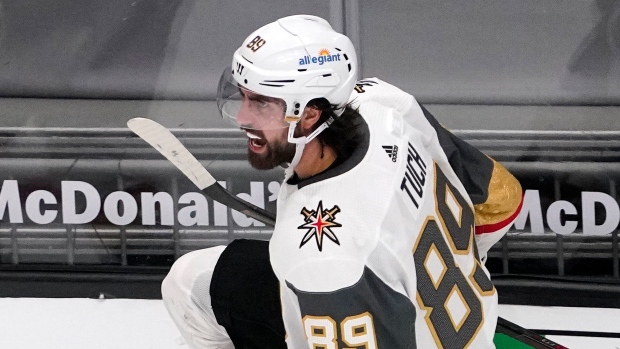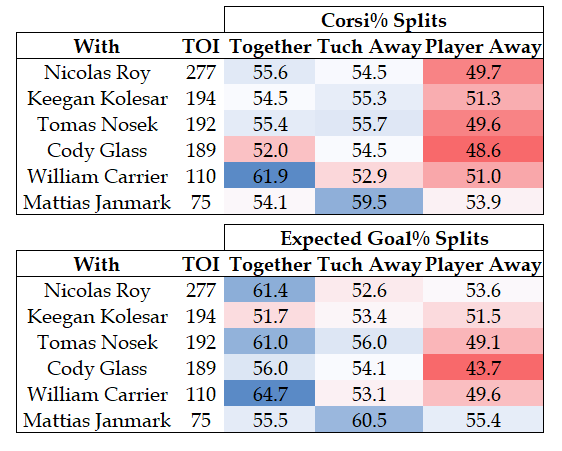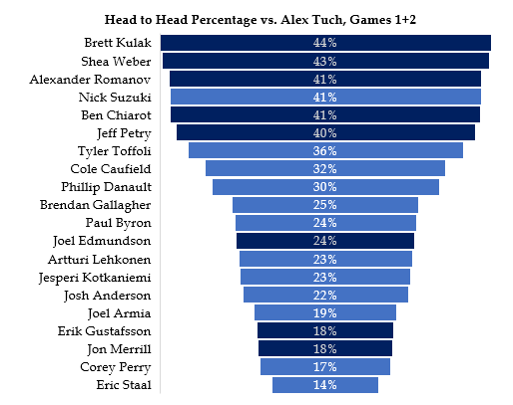Jun 18, 2021
Tuch to Golden Knights’ top line presents new wrinkle for Habs
With Chandler Stephenson missing Friday's skate, it appears Alex Tuch may slide into the top line centre role. Travis Yost has more on what that could mean for the Golden Knights.
By Travis Yost

The Montreal Canadiens were able to steal home-ice advantage from the Vegas Golden Knights after their one-goal victory in Game 2 on Wednesday night. Incredibly, this team is now three wins away from the Stanley Cup Final.
There is a new wrinkle in their third-round series against Vegas, and that’s the loss of Golden Knights first-line centre Chandler Stephenson to injury. Stephenson’s absence is particularly notable for Vegas on two fronts: the centre position is indisputably the weakest area of the lineup, and Stephenson has turned into a very effective player – his speed dynamic perfectly complementing regular linemates Mark Stone and Max Pacioretty.
Stephenson was unavailable in Game 2, and his absence was felt. The Canadiens were able to dictate play, while the Golden Knights leaned on depth options like rookie Keegan Kolesar. But in reality, the team doesn’t have a centre who can fit neatly into Stephenson’s role.
If Friday’s morning skate was any indication, Vegas head coach Peter DeBoer is prepared to try a nuclear option. In the absence of having a centre to move up, DeBoer is moving up his most dangerous player (and, I should note, the only other serious speed option outside of Stephenson) in Alex Tuch.
In short: Vegas is loading up its top line, but it’s a top line that will not feature a single regular centre option. There is an extraordinary trade-off here – the Golden Knights creating a lethal attacking unit, but one that is going to erode any talent advantage it had further down the lineup, and one that might become a mess in the faceoff circle.
We can safely assume that assembly of talent is going to give Montreal some problems – they’re big, physical, and have incredible offensive zone awareness. The Canadiens – especially with last change for the next two games – will likely throw their shutdown line, spearheaded by Philip Danault, against it. What I’m curious to see is the residual effect down the Vegas lineup, and if Montreal’s depth forwards can take advantage.
If you look at the splits of bottom-six forwards for Vegas with and without Tuch on their line, it’s night and day.

Vegas is still a game team when Tuch isn’t available in the bottom six – most of their depth forwards were able to get close to break-even in shots and expected goals without him, and that’s a luxury most teams in the NHL do not have. On the other hand, the degradation in performance from when these forwards are playing with Tuch versus without him is significant, worth about five percentage points across the board.
Tuch has been perhaps been the biggest challenge for the Canadiens defence in the first two games of the series. His line has 57 per cent of the shots and 65 per cent of the expected goals, tops for the Golden Knights. But he has also done it in softer minutes. Consider what the Canadiens threw at him in games one and two:

Montreal’s middle-six has plenty of skill, but there are a number of younger and undersized forwards in that group who would seem to be in for a difficult matchup with a player like Tuch. More polished defensive players (like Danault) or more gifted offensive zone players (like Brendan Gallagher) are surely going to see more of him going forward; players like Nick Suzuki and Cole Caufield are going to be spared.
That’s the sort of trade-off you make if you are a Canadiens fan – the best-on-best matchup would always prove difficult in this series, but suddenly the rest of the matchups are starting to look a bit more advantageous.
Enjoy the weekend games!
Data via Natural Stat Trick, NHL.com, Evolving Hockey

